文章信息
- 刘雨芳, 李菲, 桂芳艳, 王秀秀, 刘文海, 万方浩
- LIU Yufang, LI Fei, GUI Fangyan, WANG Xiuxiu, LIU Wenhai, WAN Fanghao
- 捕食者对空心莲子草叶甲种群的生物胁迫
- Biotic stress of predators on population of alligator weed flea beetle, Agasicles hygrophila (Col.:Chrysomelidae)
- 生态学报, 2014, 34(3): 613-620
- Acta Ecologica Sinica, 2014, 34(3): 613-620
- http://dx.doi.org/10.5846/stxb201207291075
-
文章历史
- 收稿日期:2012-7-29
- 修订日期:2013-10-9
2. 中国农业科学院植物保护研究所, 植物病虫害生物学国家重点实验室, 北京 100094
2. State Key Laboratory for Biology of Plant Diseases and Insect Pests, Institute of Plant Protection, Chinese Academy of Agricultural Sciences, Beijing 100094, China
室内检测与室外高密度释放均证明空心莲子草叶甲(Agasicles hygrophila)对入侵恶性杂草空心莲子草(Alternanthera philoxeroides)具有专一高效的控制作用[1, 2, 3],是重要的生物防治因子[4, 5, 6]。空心莲子草叶甲引入我国后,均在释放地建立起田间种群[3],但空心莲子草在我国的蔓延扩散与入侵并没有得到有效的控制。是什么因子影响了空心莲子草叶甲种群的田间控草效果?
自然生态系统中广泛存在着捕食者-猎物相互作用的系统,而捕食者常对植食者(猎物)种群数量起着重要的调节作用。捕食者是否影响空心莲子草叶甲种群数量,制约其控草效能,成为生物胁迫因子?为进一步探讨引起空心莲子草叶甲田间种群崩溃的胁迫因子,本研究用室内检测法,测试了捕食性昆虫龟纹瓢虫(Propylaea japonica)、蜘蛛类捕食者拟水狼蛛(Pirata subpiraticus)与斜纹猫蛛(Oxyopes sertatus)对空心莲子草叶甲各虫态在不同密度下的日捕食量。该结果将有助于了解捕食者对空心莲子草叶甲种群的生物胁迫作用,可为客观评价与利用空心莲子草叶甲的生物防治效能,为其他天敌的引进提供参考依据。
1 材料与方法 1.1 供试叶甲与捕食者空心莲子草叶甲成虫采自湖南科技大学生物园实验基地,用盒养法饲养幼虫与成虫并供成虫产卵、叶片法孵化卵粒、湿土培植笼养法化蛹[7],建立室内稳定实验种群。用吸虫器法[8]在田间采集拟水狼蛛、斜纹猫蛛与龟纹瓢虫,并挑选无损健康正常个体在室内饲养作为捕食者。其中拟水狼蛛与斜纹猫蛛用褐飞虱饲养,龟纹瓢虫用蚜虫饲养。饲养条件通过人工气候控制设备调节达到:温度(26±1)℃,相对湿度(75±5)%,光周期L ∶ D=14 ∶ 10。
1.2 实验方法 1.2.1 捕食者对空心莲子草叶甲不同虫态的捕食能力本实验中检测的空心莲子草叶甲虫态包括卵、1龄幼虫、2龄幼虫、3龄幼虫与成虫。卵块(卵粒)设1(25)、2(50)、3(75)、4(100)4个密度梯度水平,1龄幼虫设5、10、15、20、25头,2龄幼虫设4、8、12、16、20头、3龄幼虫设3、6、9、12、15头,成虫设1、2、3、4、5头5个密度梯度水平。在150 mL玻璃试管中接入1茎具4—6片叶子的空心莲子草活苗(用湿润脱脂棉包裹苗的基部,脱脂棉外用保鲜膜包裹保湿),制成测试容器。将带有卵块的叶片沿卵块大小剪成小片,用双面胶固定在测试容器中活苗的叶片背面,卵面朝外(如多个卵块时,每叶片上放一个卵块);或用毛笔挑取适合数量的各龄期幼虫与成虫,接入测试容器的活苗上。每个测试容器中接入1头经饥饿处理24 h的捕食者,用纱布与皮筋扎口后,将玻璃试管置于人工气候箱中,环境参数同1.1。24 h后观察统计各密度、各虫态处理下捕食者的捕食量。各处理均重复5次。
1.2.2 捕食者对空心莲子草叶甲不同虫态的捕食功能反应将1.2.1实验中所获各虫态各密度下的捕食量以倒数法拟合Holling II圆盘方程,用最小二乘法回归计算,因n小于50,用Fisher的t检验法对相关显著性进行检验。
Holling II型功能反应模型:Na= TaN/1+a′ThN ,式中N为猎物的密度,Na为相应密度下的捕食量,a′为瞬间攻击率,T为捕食者可利用的总时间(本研究中为1d),Th为平均处理时间(即捕食者捕食1头猎物所消耗的时间)[9]。
1.2.3 捕食者对空心莲子草叶甲不同虫态的寻找效应分析通过拟合的Holling II型功能反应模型所得参数,计算捕食者对空心莲子草叶甲不同虫态的寻找效应E。E= a′/1+a′ThN ,式中N、 a′与 Th的意义同Holling II型功能反应模型[9]。
1.3 数据分析利用统计分析软件SPSS 17.0 for windows ,对同一虫态不同密度下的捕食量进行one-Way ANOVA分析,若方差具齐性,则用LSD法进行多重比较,如方差不具齐性,则用Dunnett T3法进行多重比较;用t检验法判定捕食者对空心莲子草叶甲不同虫态的捕食与Holling II 圆盘方程拟合的相关显著性程度。对搜寻效应进行趋势线性直回归分析。
2 结果与分析 2.1 捕食者对空心莲子草叶甲不同虫态的捕食能力在不同卵块(卵粒)密度下,捕食者龟纹瓢虫、斜纹猫蛛与拟水狼蛛均捕食空心莲子草叶甲的卵粒,其捕食量如图1所示。在低卵块(卵粒)密度下,龟纹瓢虫的捕食量略高于斜纹猫蛛与拟水狼蛛,但无显著差异(P<0.05),捕食量随着猎物密度的升高而升高,但影响均不明显。其中龟纹瓢虫:F=0.471,df=3,P=0.706;斜纹猫蛛:F=1.387,df=3,P=0.283;拟水狼蛛:F=2.116,df=3,P=0.139。

|
| 图1 捕食者在不同空心莲子草叶甲卵块 (卵粒) 密度下的捕食量 Fig. 1 Daily consumption of predators to eggs in different densities of A. hygrophila |
捕食者龟纹瓢虫、斜纹猫蛛与拟水狼蛛均捕食空心莲子草叶甲1龄幼虫,其捕食量如图2所示。捕食量均随着猎物密度的升高而升高,1龄幼虫密度对龟纹瓢虫的捕食量影响不明显(F=2.647,df=4,P=0.064);对斜纹猫蛛与拟水狼蛛的影响极显著(斜纹猫蛛:F=4.835,df=4,P=0.007;拟水狼蛛:F=6.854,df=4,P=0.001)。
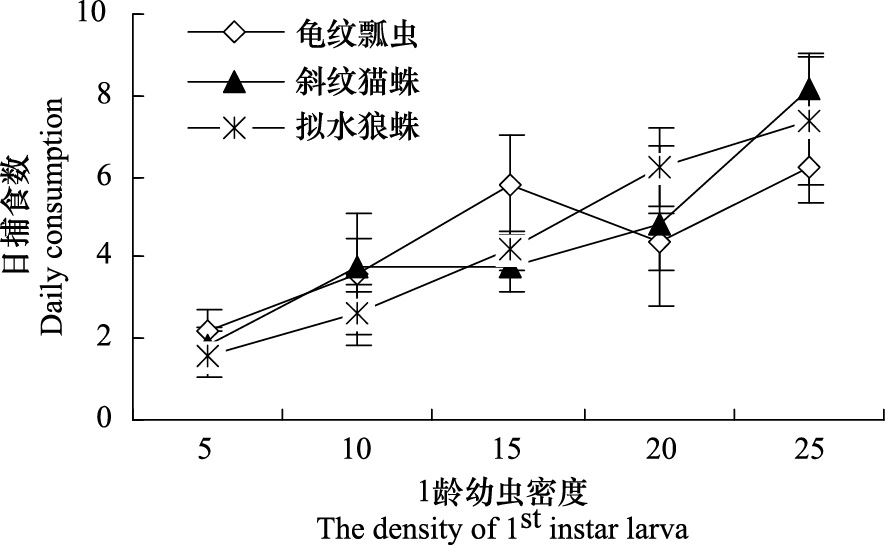
|
| 图2 捕食者在不同空心莲子草叶甲1龄幼虫密度下的捕食量 Fig. 2 Daily consumption of predators to 1st instar larva in different densities of A. hygrophila |
捕食者龟纹瓢虫、斜纹猫蛛与拟水狼蛛均捕食空心莲子草叶甲2龄幼虫,其捕食量如图3所示。捕食量均随着猎物密度的升高而升高,2龄幼虫密度对龟纹瓢虫的捕食量影响不明显(F=1.355,df=4,P=0.285);对斜纹猫蛛与拟水狼蛛的影响极显著(斜纹猫蛛:F=12.057,df=4,P=0.000;拟水狼蛛:F=9.562,df=4,P=0.000)。
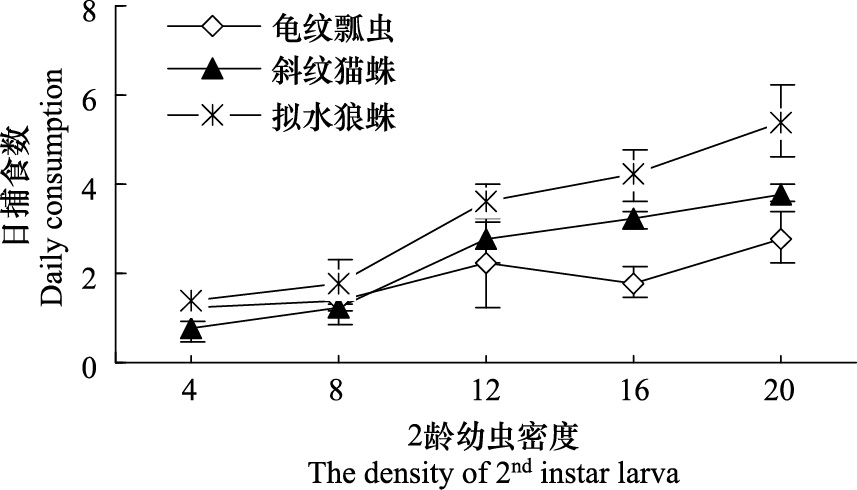
|
| 图3 捕食者在不同空心莲子草叶甲2龄幼虫密度下的捕食量 Fig. 3 Daily consumption of predators to 2nd instar larva in different densities of A. hygrophila |
龟纹瓢虫不捕食空心莲子草叶甲3龄幼虫,斜纹猫蛛与拟水狼蛛均捕食空心莲子草叶甲3龄幼虫,其捕食量如图4所示。3龄幼虫密度对斜纹猫蛛与拟水狼蛛的影响不明显(斜纹猫蛛:F=2.524,df=4,P=0.073;拟水狼蛛:F=2.765,df=4,P=0.056)。
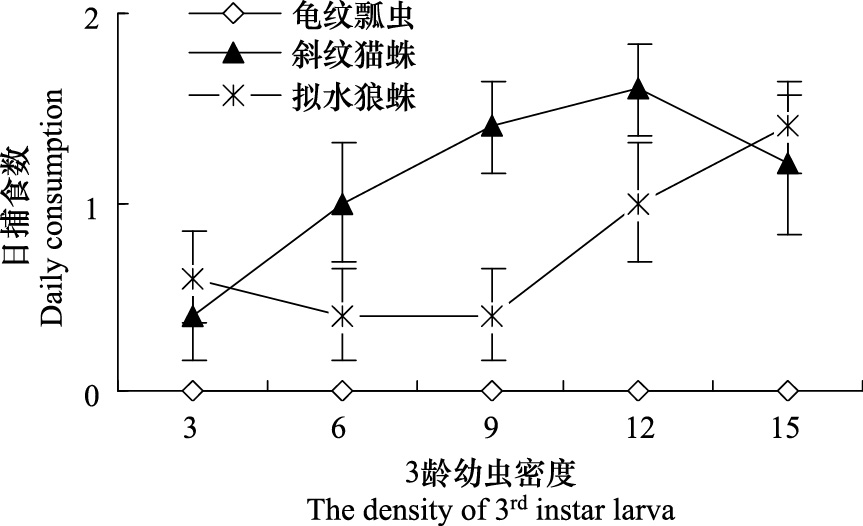
|
| 图4 捕食者在不同空心莲子草叶甲3龄幼虫密度下的捕食量 Fig. 4 Daily consumption of predators to 3rd instar larva in different densities of A. hygrophila |
在此次检测中,未发现捕食者龟纹瓢虫、斜纹猫蛛与拟水狼蛛捕食空心莲子草叶甲成虫。
2.2 捕食者对空心莲子草叶甲不同虫态的捕食功能反应通过对Holling II 方程两侧取倒数后将原方程转化为一元线性方程:1/Na=Th+1/a′N,再进行线性回归分析,分别得到捕食者龟纹瓢虫、斜纹猫蛛与拟水狼蛛捕食空心莲子草叶甲卵、1龄幼虫、2龄幼虫、3龄幼虫的拟合方程,结果分别见表 1、表 2、表 3与表 4。
|
天敌种类
Species of natural enemy | 捕食功能模型
Holling equation of predator | 相关系数(R)
Correlation coefficient | 瞬间攻击率a′
Momentary attacking rate | 处理时间(Th)
Treatment time | 日最大捕食量
Daily most prey consumed amount | t(Fisher′s) | 显著性水平
Level of significance |
| 龟纹瓢虫P. japonica | Na= 0.2048N/1+0.0369N | 0.9543 | 0.2048 | 0.1802 | 5.55 | 4.4677 | 0.05 |
| 斜纹猫蛛O. sertatus | Na= 0.0816N/1+0.0075N | 0.8988 | 0.0816 | 0.0913 | 10.95 | 2.8995 | 0.05 |
|
拟水狼蛛
P. subpiraticus | Na= 0.1419N/1+0.0228N | 0.9256 | 0.1419 | 0.1609 | 6.22 | 3.4575 | 0.05 |
|
天敌种类
Species of natural enemy | 捕食功能模型
Holling equation of predator | 相关系数(R)
Correlation coefficient | 瞬间攻击率a′
Momentary attacking rate | 处理时间(Th)
Treatment time | 日最大捕食量
Daily most prey consumed amount | t(Fisher′s) | 显著性水平
Level of significance |
| 龟纹瓢虫P. japonica | Na= 0.5653N/1+0.0544N | 0.9674 | 0.5635 | 0.0966 | 10.35 | 6.6215 | 0.01 |
| 斜纹猫蛛O. sertatus | Na= 0.4078N/1+0.0238N | 0.9747 | 0.4078 | 0.0584 | 17.11 | 7.5526 | 0.01 |
|
拟水狼蛛
P. subpiraticus | Na= 0.3252N/1+0.0091N | 0.9894 | 0.3252 | 0.0279 | 35.77 | 11.7962 | 0.01 |
|
天敌种类
Species of natural enemy | 捕食功能模型
Holling equation of predator | 相关系数(R)
Correlation coefficient | 瞬间攻击率a′
Momentary attacking rate | 处理时间(Th)
Treatment time | 日最大捕食量
Daily most prey consumed amount | t(Fisher′s) | 显著性水平
Level of significance |
| 龟纹瓢虫P. japonica | Na= 0.4757N/1+0.0238N | 0.8857 | 0.4757 | 0.3429 | 2.92 | 3.3049 | 0.05 |
| 斜纹猫蛛O. sertatus | Na= 0.2973N/1+0.0499N | 0.8803 | 0.2973 | 0.1511 | 6.62 | 3.2132 | 0.05 |
|
拟水狼蛛
P. subpiraticus | Na= 0.3742N/1+0.0333N | 0.9455 | 0.3742 | 0.0891 | 11.22 | 5.0309 | 0.02 |
|
天敌种类
Species of natural enemy | 捕食功能模型
Holling equation of predator | 相关系数(R)
Correlation coefficient | 瞬间攻击率a′
Momentary attacking rate | 处理时间(Th)
Treatment time | 日最大捕食量
Daily most prey consumed amount | t(Fisher′s) | 显著性水平
Level of significance |
| 龟纹瓢虫P. japonica | 不捕食No predacious | _ | _ | _ | _ | _ | _ |
| 斜纹猫蛛O. sertatus | Na= 0.1446N/1+0.0118N | 0.9637 | 0.1446 | 0.0815 | 12.27 | 6.2537 | 0.01 |
|
拟水狼蛛
P. subpiraticus | Na= 0.1916N/1+0.1618N | 0.6818 | 0.1916 | 0.8817 | 1.13 | 1.6145 | P > 0.05 |
龟纹瓢虫、斜纹猫蛛与拟水狼蛛捕食空心莲子草叶甲卵,均拟合Holling II功能反应模型,且均显著相关(P<0.05)。比较各参数后可知,龟纹瓢虫对卵的瞬间攻击率最高,其次是拟水狼蛛,但斜纹猫蛛蛛捕食卵的处理时间最短,分别仅为龟纹瓢虫、拟水狼蛛处理时间的50.66%与56.74%。理论上的最大捕食量以斜纹猫蛛最高,因此斜纹猫蛛对空心莲子草叶甲卵粒具有更大的捕食胁迫力(表 1)。
龟纹瓢虫、斜纹猫蛛与拟水狼蛛捕食空心莲子草叶甲1龄幼虫,均拟合Holling II功能反应模型,且均达极显著相关(P<0.01)。比较各参数后可知,龟纹瓢虫对1龄幼虫的瞬间攻击率最高,其次是斜纹猫蛛,但拟水狼蛛捕食1龄幼虫的处理时间最短,分别仅为龟纹瓢虫、斜纹猫蛛处理时间的28.88%与47.77%。拟水狼蛛理论上的最大捕食量高达35.77头,是威胁空心莲子草叶甲1龄幼虫存活的巨大胁迫力。结果也显示斜纹猫蛛与龟纹瓢虫的理论最大捕食量也较高,同样对空心莲子草叶甲1龄幼虫的存活构成较大威胁(表 2)。
龟纹瓢虫、斜纹猫蛛与拟水狼蛛捕食空心莲子草叶甲2龄幼虫,均拟合Holling II功能反应模型,且均达显著相关(P<0.05)。比较各参数后可知,龟纹瓢虫对2龄幼虫的瞬间攻击率最高,其次是拟水狼蛛,斜纹猫蛛最低。但拟水狼蛛捕食2龄幼虫的处理时间最短,分别仅为龟纹瓢虫、斜纹猫蛛处理时间的25.98%与58.97%。拟水狼蛛在理论上对2龄幼虫的最大捕食量高达11.22头,对空心莲子草叶甲2龄幼虫存活构成胁迫,斜纹猫蛛在理论上对2龄幼虫的最大捕食量为6.62头,也严重威胁空心莲子草叶甲2龄幼虫的存活。龟纹瓢虫的理论最大捕食量较低,对空心莲子草叶甲2龄幼虫的存活有一定的不利影响(表 3)。
龟纹瓢虫不捕食空心莲子草叶甲3龄幼虫,因此不对其构成生存威胁。斜纹猫蛛捕食空心莲子草叶甲3龄幼虫,拟合Holling II功能反应模型,呈极显著相关(P < 0.01)。拟水狼蛛捕食空心莲子草叶甲3龄幼虫,拟合Holling II功能反应模型,相关性不显著(P > 0. 05)。斜纹猫蛛捕食3龄幼虫的处理时间仅为拟水狼蛛的9.24%。斜纹猫蛛在理论上对3龄幼虫的最大捕食量高达12.27头,成为空心莲子草叶甲3龄幼虫存活的生物胁迫因子(表 4)。
2.3 捕食者对空心莲子草叶甲不同虫态的寻找效应对捕食者龟纹瓢虫、斜纹猫蛛与拟水狼蛛捕食不同密度下的空心莲子草叶甲卵粒所得的搜寻效应与卵密度间进行趋势线性直回归分析,结果表明捕食者捕食卵粒时,其搜寻效应均随卵密度的增加呈线性下降(图5)。龟纹瓢虫:Y1=-0.0206X+0.1207,R2=0.9353;斜纹猫蛛:Y2=-0.0073X+0.0751,R2=0.9870;拟水狼蛛:Y3=-0.0155X+0.1019,R2=0.9545。比较回归方程的系数可知,龟纹瓢虫捕食卵时搜寻效应受卵的密度影响最大,随卵密度增加其搜寻效应下降趋势最大,拟水狼蛛次之,斜纹猫蛛捕食卵时,随卵的增加搜寻效应下降趋势不明显。
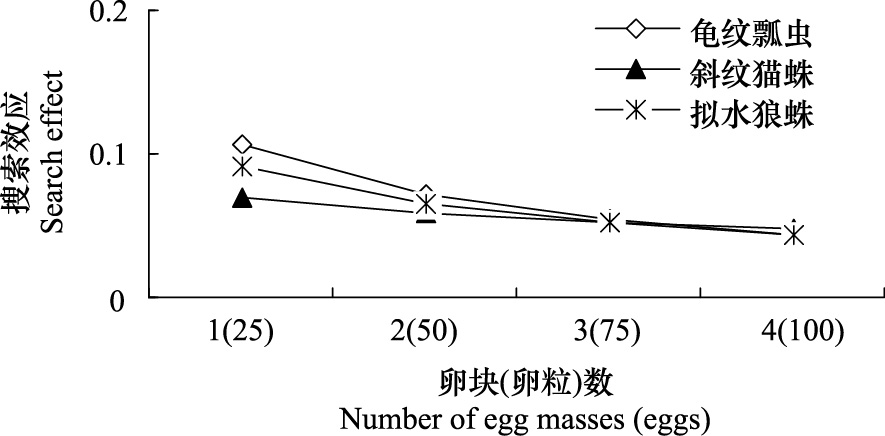
|
| 图5 捕食者对不同密度空心莲子草叶甲卵粒的搜寻反应 Fig. 5 The search effect of predators to eggs in different densities of A. hygrophila |
捕食者捕食1龄、2龄与3龄幼虫时,其搜寻效应与猎物密度间的趋势线性直回归分析,显示了与捕食卵粒时的相似结果。即捕食者的搜寻效应均随着猎物密度的增加呈线性下降(图6—图8)。对于1龄幼虫的搜寻效应,龟纹瓢虫:Y1=-0.0504X+0.4764,R2=0.9674;斜纹猫蛛:Y2=-0.0271X+0.3864,R2=0.9891;拟水狼蛛:Y3=-0.0115X+0.3216,R2=0.9978。龟纹瓢虫捕食1龄幼虫时搜寻效应受幼虫的密度影响最大,随幼虫密度增加其搜寻效应下降趋势最大,斜纹猫蛛次之,拟水狼蛛捕食1龄幼虫时猎物的增加搜寻效应下降趋势不明显(图6)。

|
| 图6 捕食者对不同密度空心莲子草叶甲1龄幼虫的搜寻反应 Fig. 6 The search effect of predators to 1st instar larva in different densities of A. hygrophila |
对于2龄幼虫的搜寻效应,龟纹瓢虫:Y1=-0.042X+0.3078,R2=0.9260;斜纹猫蛛:Y2=-0.0237X+0.2697,R2=0.9805;拟水狼蛛:Y3=-0.0263X+0.3511,R2=0.9871。龟纹瓢虫捕食2龄幼虫时搜寻效应受幼虫的密度影响最大,随幼虫密度增加其搜寻效应下降趋势最大,拟水狼蛛与斜纹猫蛛捕食2龄幼虫时,随着猎物的增加搜寻效应下降趋势较明显(图7)。对于3龄幼虫的搜寻效应,斜纹猫蛛:Y2=-0.0042X+0.1435,R2=0.9986;拟水狼蛛:Y3=-0.0178X+0.1365,R2=0.9394。拟水狼蛛捕食3龄幼虫时搜寻效应受幼虫的密度影响较大,随幼虫密度增加其搜寻效应下降趋势明显,斜纹猫蛛捕食3龄幼虫时随猎物的增加搜寻效应呈下降趋势,但其斜率的绝对值小于拟水狼蛛的反应线(图8)。
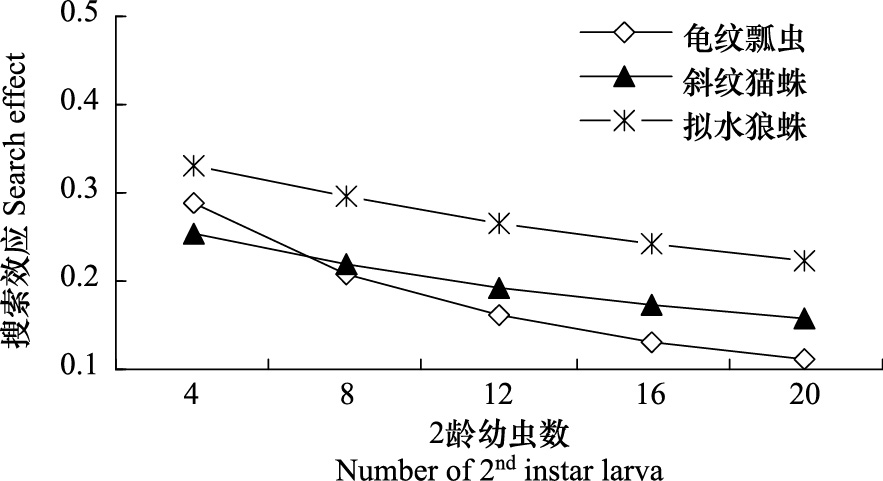
|
| 图7 捕食者对不同密度空心莲子草叶甲2龄幼虫的搜寻反应 Fig. 7 The search effect of predators to 2nd instar larva in different densities of A. hygrophila |
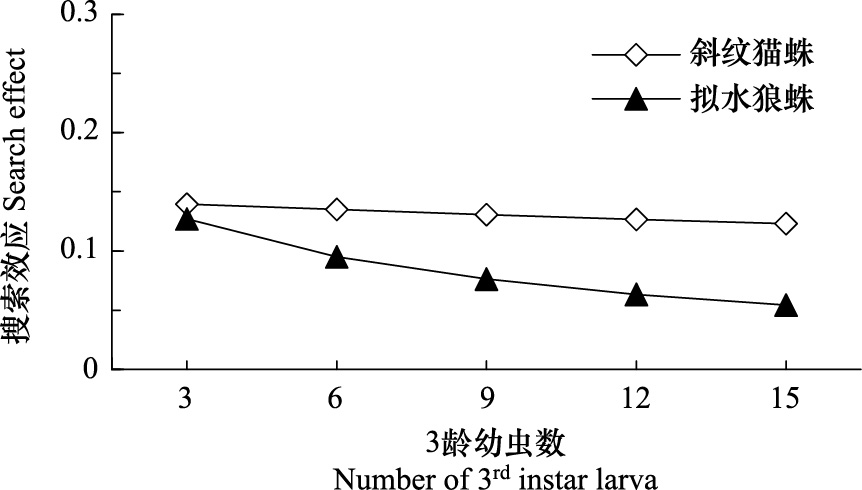
|
| 图8 捕食者对不同密度空心莲子草叶甲3龄幼虫的搜寻反应 Fig. 8 The search effect of predators to 3rd instar larva in different densities of A. hygrophila |
捕食者-猎物系统的相关数量动态关系普遍存在于自然生态系统中,这种动态关系常被用于了解害虫的种群动态[10]、评估捕食者的捕食效能与控害能力[11],并应用于害虫生物防治。蜘蛛、昆虫等大多数无脊椎动物的功能反应拟合Holling II 圆盘方程[9, 11]。如龟纹瓢虫成虫对亚洲玉米螟卵的捕食[12]、大草蛉(Chrysopa pallens)幼虫对烟粉虱(Bemisia tabaci)的捕食[13]、红脚姬蛛(Nesticodes rufipes)对舍蝇(Musca domestica)的捕食[11]均拟合Holling II功能反应模型。该模型表达了单个捕食者捕食的时间速率,即单位时间内杀死猎物的平均数量,是逆密度制约的一上渐进线或负加速线[9, 11] 。本研究表明捕食者龟纹瓢虫、斜纹猫蛛与拟水狼蛛均捕食空心莲子草叶甲卵粒、1龄幼虫、2龄幼虫,斜纹猫蛛与拟水狼蛛还捕食空心莲子草叶甲3龄幼虫。虽然拟水狼蛛对3龄幼虫的捕食用Holling II 方程拟合,其相关性不显著,但拟水狼蛛捕食3龄幼虫时搜寻效应呈密度制约型,随幼虫密度增加其搜寻效应下降趋势明显。其他捕食反应用Holling II 模型进行拟合,均呈显著或极显著相关关系。他们对猎物的搜寻效应均随着猎物密度的增加呈降低趋势。由此可知,捕食者通过捕食作用降低叶甲种群数量与密度,直接削弱叶甲对空心莲子草的控害效能,是空心莲子草叶甲种群存活的生物胁迫因子。
在野外调查时发现,在空心莲子草群落中,捕食性天敌亚群落的物种组成很复杂,除了上述检测的3种常见捕食者外,还有如异色瓢虫(Leis axyridis)、青翅蚁形隐翅虫(Paederus fuscipes)、各种步甲、螳螂、猎蝽、膜翅目等捕食性昆虫,以及狼蛛科、皿蛛科、跳蛛科、肖蛸科、球蛛科、圆蛛科、蟹蛛科等各类蜘蛛。尽管在室内的测试,3种捕食者均不取食叶甲成虫,但在田间空心莲子草植株上、蛛网上常可见残存的叶甲成虫外壳或尸体。由此推断,田间捕食者对空心莲子草叶甲各虫态、各龄期幼虫可能存在广泛的捕食,捕食胁迫关系可能比直接观察结果更复杂。
捕食者-猎物系统是个复杂的相互作用关系的系统,一方面捕食性天敌直接捕食猎物,影响猎物的种群密度,实现对猎物的种群调节,另一方面,引起猎物某些习性的改变,间接影响猎物的适合度,从而影响猎物的种群数量[13, 14]。同时捕食者种群的扩散聚集效应、寻找效应、选择效应、饥饱水平、干扰效应等,及猎物的逃避作用、饱和作用,捕食者与猎物种群各自对环境因素的适应、种内种间的竞争以及种群自身的调节作用均影响捕食效应[9]。由于捕食功能反应的田间实验存在技术困难,大多数研究只能在室内进行[15],本文研究也不例外,且只实现在控制条件下对少数几种常见捕食者对猎物当代的捕食效应检测,证明了自然生态系统中存在的大量捕食者是空心莲子草叶甲种群存活的生物胁迫因子,未进行连代胁迫后猎物适合性变化的实验。天敌的捕食胁迫是否能提高空心莲子草叶甲自身的生物学适合度,如提高其迁移能力、内禀增长率等,有待进一步研究。
| [1] | Wu Z Q, Cai Y C, Guo Z X, Wang T B. Host specificity tests for Agasicles hygrophilia (Col: Chrysomelidae), a biological control agent of alligator weed. Entomological Journal of East China, 1994, 3(2): 98-100. |
| [2] | Stewart C A, Chapman R B, Emberson R M, Syrett P, Frampton C M A. The effect of temperature on the development and survival of Agasicles hygrophila Selman & Vogt (Coleoptera: Chrysomelidae), a biological control agent for alligator weed (Alternanthera philoxeroides). New Zealand Journal of Zoology, 1999, 26(1): 11-20. |
| [3] | Liu Y F, Su W J, Zeng Q G, Li F, Peng M F, Peng J X, Liu W H, Wan F H. Quantitative evaluation of the controlling effects of Agasicles hygrophila (Coleoptera: Chrysomelidae) on alligator weed (Alternanthera philoxeroides). Acta Entomologica Sinica, 2011, 54(11): 1305-1311. |
| [4] | Sainty G, McCorkelle G, Julien M. Control and spread of alligator weed Alternanthera philoxeroides (Mart.) Griseb., in Australia: Lessons for other regions. Wetlands Ecology and Management, 1998, 5: 195-201. |
| [5] | Julien M H, Skarratt B, Maywald G F. Potential geographical distribution of alligator weed and its biological control by Agasicles hygrophila. Journal of Aquatic Plant Management, 1995, 33: 55-60. |
| [6] | Li H K, Li M, Li D. Alligator weed Alternanthera philoxeroides and its biological control. World Agriculture, 2000, (2): 36-36. |
| [7] | Liu Y F, Liu W H, Wan F H. Massive rearing of the alligator weed flea beetle, Agasicles hygrophila (Coleoptera: Chrysomelidae), in the laboratory. Acta Entomologica Sinica, 2009, 52(8): 867-874. |
| [8] | Liu Y F, Zhang G R, Gu D X. Improving insect suction sampling machine to study arthropods community in paddy fields. Plant Protection, 1999, 25(6): 39-40. |
| [9] | Ding Y Q. Mathematical Ecology of Insects. Beijing: Sciences Press, 1994: 235-399. |
| [10] | Tian Y L, Weng P X. Stability analysis of diffusive predator-prey model with modified leslie-gower and holling-type II Schemes. Acta Applicandae Mathematicae, 2011, 114(3): 173-192. |
| [11] | Rossi M N, Reigada C, Godoy W A C. The effect of hunger level on predation dynamics in the spider Nesticodes rufipes: a functional response study. Ecological Research, 2006, 21(5): 617-623. |
| [12] | Xin Z J, Zhuo D G, Li Z H. Predatory functional responses of Propylaea japonica adults on eggs of Ostrinia furnacalis. Journal of Shandong Agricultural University: Natural Science, 2011, 42(2): 191-193. |
| [13] | Liu S, Wang S, Liu B M, Zhou C Q, Zhang F. The predation function response and predatory behavior observation of Chrysopa pallens larva to Bemisia tabaci. Scientia Agricultura Sinica, 2011, 44(6): 1136-1145. |
| [14] | Kunert G, Weisser W W. The interplay between density-and trait-mediated effects in predator-prey interactions: a case study in aphid wing polymorphism. Oecologia, 2003, 135(2): 304-312. |
| [15] | Marc P, Canard A, Ysnel F. Spiders (Araneae) useful for pest limitation and bioindication. Agriculture, Ecosystems and Environment, 1999, 74(1/3): 229-273. |
| [1] | 吴珍泉, 蔡元呈, 郭振铣, 王天宝. 空心莲子草叶甲寄主专一性测验. 华东昆虫学报, 1994, 3(2): 98-100. |
| [3] | 刘雨芳, 苏文杰, 曾强国, 李菲, 彭梅芳, 彭佳星, 刘文海, 万方浩. 空心莲子草叶甲对空心莲子草控制效果的定量评价. 昆虫学报, 2011, 54(11): 1305-1311. |
| [6] | 李宏科, 李萌, 李丹. 空心莲子草及其生物防治. 世界农业, 2000, (2): 36-36. |
| [7] | 刘雨芳, 刘文海, 万方浩. 空心莲子草叶甲室内大量繁殖研究. 昆虫学报, 2009, 52(8): 867-874. |
| [8] | 刘雨芳, 张古忍, 古德祥. 利用改装的吸虫器研究稻田节肢动物群落. 植物保护, 1999, 25(6): 39-40. |
| [9] | 丁岩钦. 昆虫数学生态学. 北京: 科学出版社, 1994: 235-399. |
| [12] | 辛肇军, 卓德干, 李照会. 龟纹瓢虫成虫对亚洲玉米螟卵的捕食作用. 山东农业大学学报: 自然科学版, 2011, 42(2): 191-193. |
| [13] | 刘爽, 王甦, 刘佰明, 周长青, 张帆. 大草蛉幼虫对烟粉虱的捕食功能反应及捕食行为观察. 中国农业科学, 2011, 44(6): 1136-1145. |
 2014, Vol. 34
2014, Vol. 34




